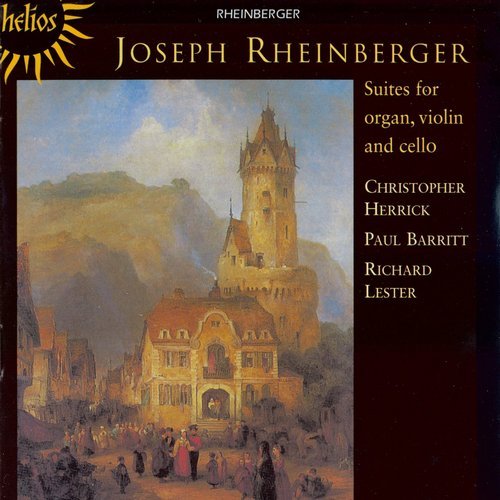
Christopher Herrick, Paul Barritt, Richard Lester - Rheinberger: Suites for Organ, Violin and Cello (2005)
BAND/ARTIST: Christopher Herrick, Paul Barritt, Richard Lester
- Title: Rheinberger: Suites for Organ, Violin and Cello
- Year Of Release: 2005
- Label: Hyperion
- Genre: Classical
- Quality: FLAC (image+.cue,log,scans)
- Total Time: 63:38
- Total Size: 287 Mb
- WebSite: Album Preview
Tracklist:
Joseph Rheinberger (1839-1901)
[1]-[4] Suite for organ, violin and cello, Op.149
[5]-[10] Six Pieces for violin and organ, Op.150
Performers:
Paul Barritt, violin
Richard Lester, cello
Christopher Herrick, organ
Joseph Rheinberger (1839-1901)
[1]-[4] Suite for organ, violin and cello, Op.149
[5]-[10] Six Pieces for violin and organ, Op.150
Performers:
Paul Barritt, violin
Richard Lester, cello
Christopher Herrick, organ
If Saint-Saëns has been called the French Mendelssohn, in a curious turnabout, Joseph Rheinberger (1839?1901) might be called the German Saint-Saëns. Both composers were accomplished organists for whom the instrument played a major role in their professional careers. Both composers labored in the field of opera, neither, however?notwithstanding Saint-Saëns?s Samson et Dalila ?with much success. Both composers found their main calling in instrumental, chamber, and, in Saint-Saëns?s case, orchestral music. Both composers were exceptionally gifted with a muse for voluptuous melody Read more Samson et Dalila should have been criticized as being too Wagnerian (he was too German for the French), and that Rheinberger?s lifelong love affair with the organ should have been seen as obeisance to the Franco-Belgian organ tradition (he was too French for the Germans). Most of Rheinberger?s music today lives at the fringes of the standard repertoire, but he is largely remembered as an important teacher whose students included Humperdinck, Wolf-Ferrari, and Wilhelm Furtwängler.
The current release on Hyperion?s budget Helios label originally appeared in 1996 as CDA 66883. The substitution of organ for piano in duo chamber works with violin is a bit unusual, though to Rheinberger it must have seemed perfectly logical and natural. The Suite is, in all but name, a formally fashioned four-movement work, which, in its employment of violin, cello, and organ, and in its overlapping imitative entries, is less suggestive of a standard piano trio than it is a Baroque trio sonata. The opening melody will not only captivate you, it will immediately reinforce the analogy to Saint-Saëns.
The Baroque suite or sonata da camera idea is further advanced in the Six Pieces, though Rheinberger offers his own unique arrangement of movements by placing the Gigue in the middle and the Overture at the end. Considerations of formal organization aside, the piece comes across as an updated 19th-century model of 17th-century Italian instrumental chamber music style?the famously souped-up version of Vitali?s Chaconne comes to mind. Still, the pouring forth from Rheinberger?s seemingly inexhaustible reservoir of songful and soulful melody is irresistible.
These were wonderful performances when they first appeared, and though a more recent identical coupling has been released on the Cantate label, it is hard to imagine Barritt, Lester, and Herrick being bettered. If you missed it the first time around, here?s your opportunity to pick this up, and at a bargain price. -- Jerry Dubins
The current release on Hyperion?s budget Helios label originally appeared in 1996 as CDA 66883. The substitution of organ for piano in duo chamber works with violin is a bit unusual, though to Rheinberger it must have seemed perfectly logical and natural. The Suite is, in all but name, a formally fashioned four-movement work, which, in its employment of violin, cello, and organ, and in its overlapping imitative entries, is less suggestive of a standard piano trio than it is a Baroque trio sonata. The opening melody will not only captivate you, it will immediately reinforce the analogy to Saint-Saëns.
The Baroque suite or sonata da camera idea is further advanced in the Six Pieces, though Rheinberger offers his own unique arrangement of movements by placing the Gigue in the middle and the Overture at the end. Considerations of formal organization aside, the piece comes across as an updated 19th-century model of 17th-century Italian instrumental chamber music style?the famously souped-up version of Vitali?s Chaconne comes to mind. Still, the pouring forth from Rheinberger?s seemingly inexhaustible reservoir of songful and soulful melody is irresistible.
These were wonderful performances when they first appeared, and though a more recent identical coupling has been released on the Cantate label, it is hard to imagine Barritt, Lester, and Herrick being bettered. If you missed it the first time around, here?s your opportunity to pick this up, and at a bargain price. -- Jerry Dubins
DOWNLOAD FROM ISRA.CLOUD
Rheinberger - Suites for Organ, Violin and Cello (2005) CD-Rip.rar - 287.8 MB
Rheinberger - Suites for Organ, Violin and Cello (2005) CD-Rip.rar - 287.8 MB
Classical | FLAC / APE | CD-Rip
As a ISRA.CLOUD's PREMIUM member you will have the following benefits:
- Unlimited high speed downloads
- Download directly without waiting time
- Unlimited parallel downloads
- Support for download accelerators
- No advertising
- Resume broken downloads


